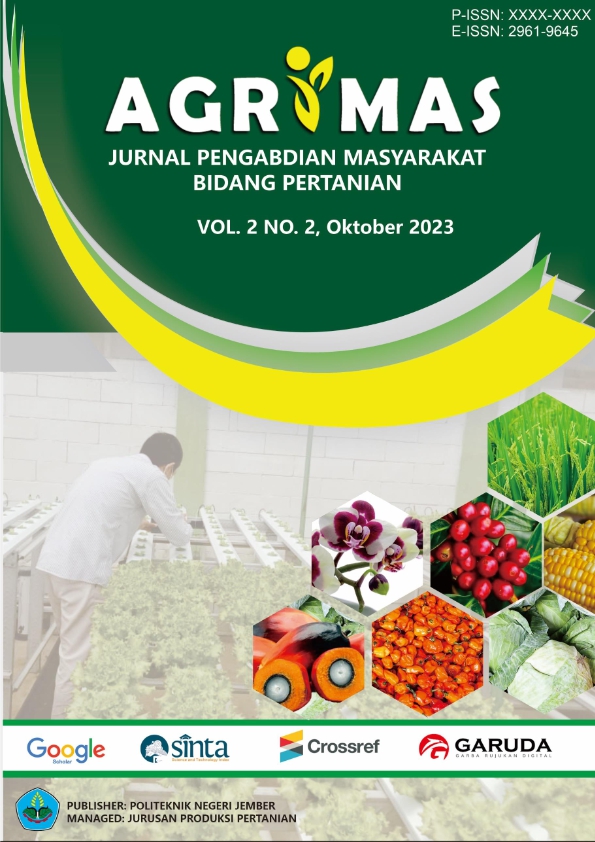Pembuatan Asap Cair, Biochar, dan Arang Aktif dengan Alat Pirolisis Detachable pada Rintisan Teaching Factory Pembibitan Politeknik Negeri Jember
DOI:
10.25047/agrimas.v2i2.40Downloads
Abstract
The problem of land fertility on the Jember State Polytechnic land is an important matter to be addressed, so there is a need for land rehabilitation to maintain land fertility. Politeknik Negeri Jember has an abundance of agricultural waste such as coconut shells, coffee shells, cocoa shells, rice husks and corn cobs which have the potential to be used as organic products that are beneficial for land fertility. Based on this, the community service implementation team proposes to provide a solution by utilizing agricultural waste into biochar, bio-oil and activated charcoal products which play a role in soil fertility. The proposing team together with the management of the Nursery Teaching Factory pilot agreed to make a pyrolysis tool to produce biochar, bio-oil and activated charcoal which functions for land rehabilitation. The service activity began with a Forum Group Discussion (FGD) between the proposing team and the TeFa Nursery management to agree on determining the SOP for product manufacture, location and equipment maintenance. The proposing team also provides assistance in testing product content, packaging, product legality, and product marketing for program sustainability. After this activity, it is hoped that there will be income from product sales, additional investment in equipment, and management of agricultural waste raw materials.
Keywords:
land, waste, media, shell, fertilityReferences
Badan Pusat Statistik Kabupaten Jember, “Kabupaten Jember Dalam Angka,” Jember, 2022.
R. Phuong,D.T.M., Miyanishi, T., Okayama, T., Kose, “Pore characteristics and adsorption capacities of biochars derived from rice residues as affected by variety and pyrolysis temperature,” Am. J. Innov. Res. Appl. Sci., vol. 2, pp. 179–189, 2016.
K. Y. Chan, L. Van Zwieten, I. Meszaros, A. Downie, and S. Joseph, “Agronomic values of greenwaste biochar as a soil amendment,” Soil Res., vol. 45, no. 8, pp. 629–634, 2007.
M. H. Abdillah, M. Lukmana, I. Indriani, and R. Nur, “Iptek bagi Masyarakat dalam Mengolah Biomassa menjadi Biochar dan Asap Cair Menggunakan Pirolisator Portabel,” Sasambo J. Abdimas (Journal Community Serv., vol. 5, no. 1, pp. 14–23, 2023.
L. Ajema, “Effects of biochar application on beneficial soil organism,” Int. J. Res. Stud. Sci. Eng. Technol., vol. 5, pp. 9–18, 2018.
J. Tang, W. Zhu, R. Kookana, and A. Katayama, “Characteristics of biochar and its application in remediation of contaminated soil,” J. Biosci. Bioeng., vol. 116, no. 6, pp. 653–659, 2013.
S. Steinbeiss, G. Gleixner, and M. Antonietti, “Effect of biochar amendment on soil carbon balance and soil microbial activity,” Soil Biol. Biochem., vol. 41, no. 6, pp. 1301–1310, 2009.
A. Dariah, S. Sutono, L. Nurida, W. Hartatik, and E. Pratiwi, “Pembenah tanah untuk meningkatkan produktivitas lahan pertanian,” 2015.
N. L. Neneng and R. Achmad, “Biochar Pembenah Tanah Yang Potensial.” IAARD Press, 2015.
I. Aisyah, N. Juli, and G. Pari, “Pemanfaatan asap cair tempurung kelapa untuk mengendalikan cendawan penyebab penyakit antraknosa dan layu Fusarium pada ketimun,” J. Penelit. Has. Hutan, vol. 31, no. 2, pp. 170–178, 2013.
S. Soldera, N. Sebastianutto, and R. Bortolomeazzi, “Composition of phenolic compounds and antioxidant activity of commercial aqueous smoke flavorings,” J. Agric. Food Chem., vol. 56, no. 8, pp. 2727–2734, 2008.
F. R. RESTUHADI, “Karakteristik asap cair dari proses pirolisis limbah sabut kelapa muda,” Sagu, vol. 14, no. 2, pp. 43–50, 2015.
S. A. Nurfaritsya, I. Rusnandi, and R. Daniar, “Pengaruh Variasi Temperatur dan Waktu Proses Pirolisis Tatal Kayu Karet untuk Pembuatan Bio-Char, Bio-Oil dan Syngas sebagai Bahan Bakar,” J. Pendidik. Tambusai, vol. 7, no. 3, pp. 24569–24576, 2023.
M. I. Jahirul, M. G. Rasul, A. A. Chowdhury, and N. Ashwath, “Biofuels production through biomass pyrolysis—a technological review,” Energies, vol. 5, no. 12, pp. 4952–5001, 2012.
S. Yuwanti, “Asap cair sebagai pengawet alami pada bandeng presto,” Agritech, vol. 25, no. 1, pp. 36–40, 2005.
S. Husseinsyah and M. Mostapha, “The effect of filler content on properties of coconut shell filled polyester composites,” Malaysian Polym. J., vol. 6, no. 1, pp. 87–97, 2011.
F. Assidiq, T. D. Rosahdi, and B. V. El Viera, “Pemanfaatan asap cair tempurung kelapa dalam pengawetan daging sapi,” al Kim. J. Ilmu Kim. dan Terap., vol. 5, no. 1, pp. 34–41, 2018.
I. Isa, W. J. Musa, and S. W. Rahman, “Pemanfaatan asap cair tempurung kelapa sebagai pestisida organik terhadap mortalitas ulat grayak (Spodoptera litura F.),” Jambura J. Chem., vol. 1, no. 1, pp. 15–20, 2019.
S. Sudarmo and S. Mulyaningsih, Mudah Membuat Pestisida Nabati Ampuh. AgroMedia, 2014.
M. Lempang, “Pembuatan dan kegunaan arang aktif,” Bul. Eboni, vol. 11, no. 2, pp. 65–80, 2014.
I. Syauqiah, M. Amalia, and H. A. Kartini, “Analisis variasi waktu dan kecepatan pengaduk pada proses adsorpsi limbah logam berat dengan arang aktif,” Info-Teknik, vol. 12, no. 1, pp. 11–20, 2011.
S. Jamilatun and M. Setyawan, “Pembuatan arang aktif dari tempurung kelapa dan aplikasinya untuk penjernihan asap cair,” Spektrum Ind., vol. 12, no. 1, pp. 1–112, 2014.
License
Copyright (c) 2023 Irma Harlianingtyas, Sugiyarto Sugiyarto, Cherry Triwidiarto, Supriyadi Supriyadi

This work is licensed under a Creative Commons Attribution 4.0 International License.
You are free to:
- Share — copy and redistribute the material in any medium or format for any purpose, even commercially.
- Adapt — remix, transform, and build upon the material for any purpose, even commercially.
The licensor cannot revoke these freedoms as long as you follow the license terms.
Under the following terms:
- Attribution — You must give appropriate credit, provide a link to the license, and indicate if changes were made. You may do so in any reasonable manner, but not in any way that suggests the licensor endorses you or your use.
- No additional restrictions — You may not apply legal terms or technological measures that legally restrict others from doing anything the license permits.
Notices:
You do not have to comply with the license for elements of the material in the public domain or where your use is permitted by an applicable exception or limitation.
No warranties are given. The license may not give you all of the permissions necessary for your intended use. For example, other rights such as publicity, privacy, or moral rights may limit how you use the material.





